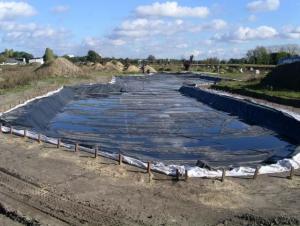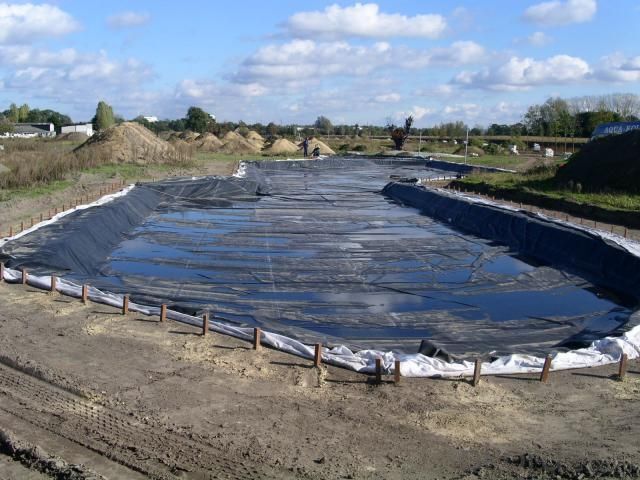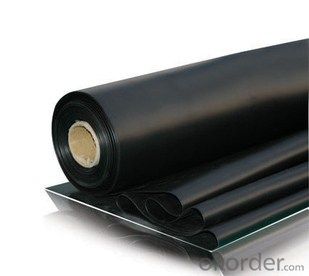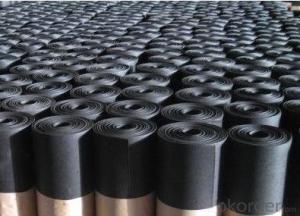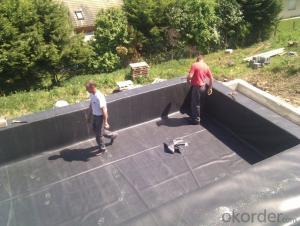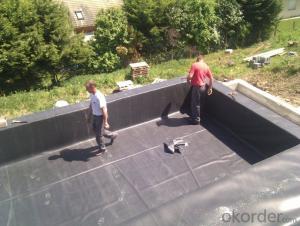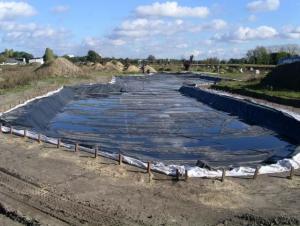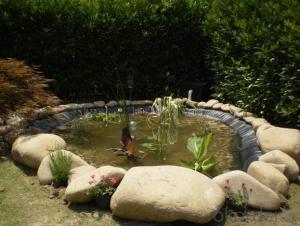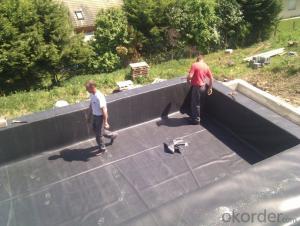EPDM Coiled Rubber Waterproof Membrane for Linear Pond
- Loading Port:
- Shanghai
- Payment Terms:
- TT OR LC
- Min Order Qty:
- 20000 m²
- Supply Capability:
- 5000000 m²/month
OKorder Service Pledge
OKorder Financial Service
You Might Also Like
EPDM Coiled Rubber Waterproof Membrane for Linear Pond
Description Of EPDM Coiled Rubber Waterproof Membrane for Linear Pond:
This waterproof coiled material is of high elasticity with best performance among high polumer
waterproof coiled material in the world.It is also the most typical one in the world.Waterproof coiled material made of ternary ethylene-propylene rubber is produced withthe use of the most advanced contiuous extrusion and vulcanization technology and related equipments which are specially designed for production of such product.It is good in compactness,without bubble and performance difference in length and breadth,perfomances reach or exceedthe demands of GB18173.1-2000 standard.
Main Features of EPDM Coiled Rubber Waterproof Membrane for Linear Pond:
A.Polyester based SBS Modified Bitumen Waterproofing Membrane
a. Strong impermeability
b. High tensile strength, elongation, ability to adapt the grassroots shrinkage deformation and cracking
c. Puncture-resistant, broken resistant, tear-resistant
d. The corrosion resistance, resistance to mildew, weathering good
e. Construction convenient, hot-melt can be operated Four Seasons Construction, reliable joints
B. Fiberglass based SBS Modified Bitumen Waterproofing Membrane
a. High tensile strength, stability of a good size
b. High Temperature good performance
c. Damage resistance, corrosion resistance, resistance to mildew, weathering good performance
d. Good construction performance, reliable joints.
Specifications of EPDM Coiled Rubber Waterproof Membrane for Linear Pond:
| Material | EPDM Rubber |
| Size | 1.2m (width)*20m (length) or customized, weldable type 2.05m or 4m width |
| Thick | 1.2mm, 1.5mm, 2.0mm |
| Type | Vulcanized & Weldable |
| Pattern | Non-reinforced (homogeneous) |
| Certificate | ISO9001/14001 |
Applications of EPDM Coiled Rubber Waterproof Membrane for Linear Pond:
1. Roofs, Basement, Toilet
2. Industrial and civil building waterproofing
3. Geo-synthetic liner for swimming pool, channels, irrigation system
4. Especially suit for projects with high requirements in durability, anti-corrosion and deformation
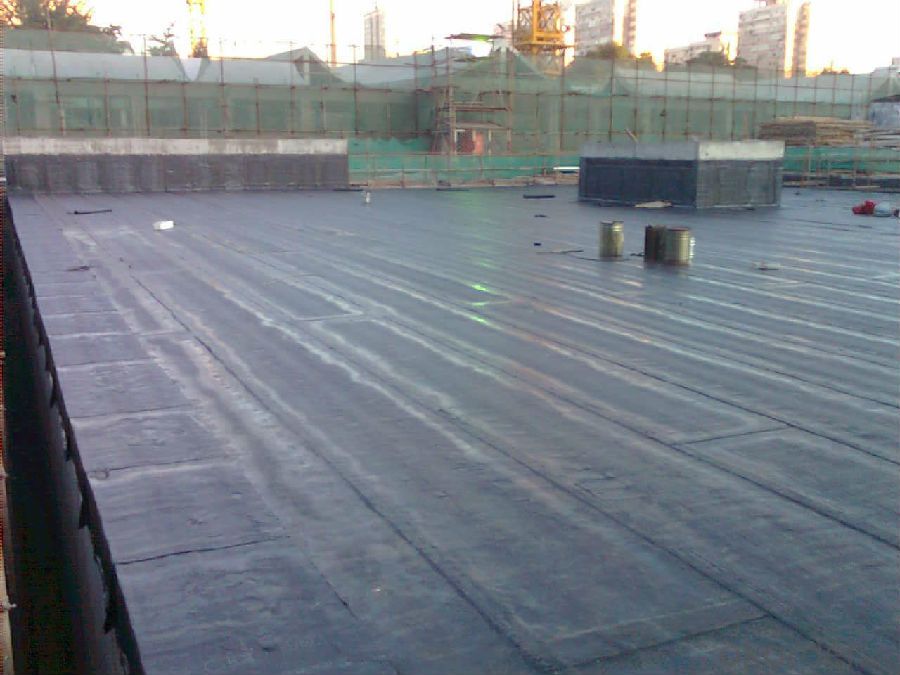
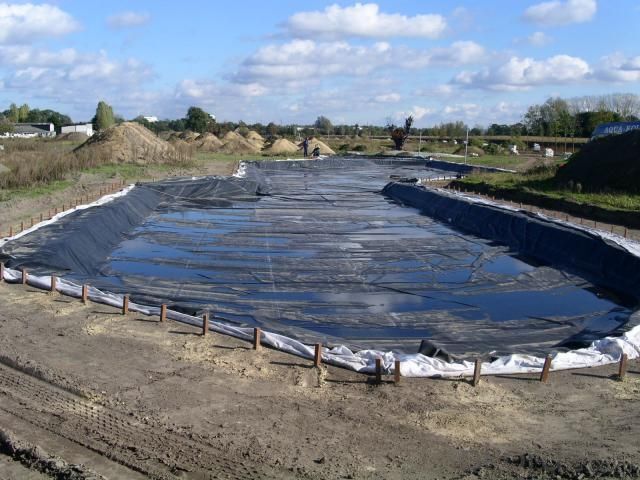

IMages of EPDM Coiled Rubber Waterproof Membrane for Linear Pond:




FAQ of EPDM Coiled Rubber Waterproof Membrane for Linear Pond:
1. What are we supplying?
We are specialized in producing Colorful Asphalt Roof Shingle, SBS/APP modified bitumen waterproof membrane, Self adhesive bitumen waterproof membrane, PVC waterproofing membrane, EPDM rubber roofing membrane, Single Component Polyurethane Waterproof Coating, and Spray Polyurea Waterproof Coating
.
2. How Many years experience do we have?
We have been exported to more than 20 countries in the past 15 years.
3. How long do we usually reply your request?
We always reply our customer within 24 hours.
- Q: Can waterproofing membranes be applied in cold weather?
- Yes, waterproofing membranes can be applied in cold weather. However, it is important to consider a few factors when applying these membranes in low temperatures. Cold weather can affect the curing process of the membrane, potentially slowing it down. It is crucial to ensure that the surface being waterproofed is dry and free from ice or frost before applying the membrane. Additionally, some waterproofing products may have specific temperature requirements for optimal performance, so it is essential to consult the manufacturer's guidelines. In colder temperatures, it may also be necessary to use specialized adhesives or primers designed for cold weather applications. Overall, with proper precautions and the use of appropriate materials, waterproofing membranes can be successfully applied in cold weather.
- Q: Is a waterproofing membrane resistant to hydrocarbons or oils?
- Typically, waterproofing membranes are resistant to hydrocarbons and oils. The materials utilized in these membranes, such as bitumen or synthetic polymers, are specifically engineered to possess strong resistance against different chemicals, including hydrocarbons and oils. This resistance guarantees that the membrane remains efficient in obstructing water penetration even when confronted with these substances. Nevertheless, it is crucial to acknowledge that the resistance level may differ depending on the type and quality of the waterproofing membrane. It is advisable to consult the manufacturer or supplier to ascertain the precise resistance capabilities of a given waterproofing membrane.
- Q: Can a waterproofing membrane be used on precast concrete surfaces?
- Yes, a waterproofing membrane can be used on precast concrete surfaces. Precast concrete surfaces are commonly used in construction for various applications such as walls, floors, and roofs. These surfaces are prone to water penetration, which can cause damage and deterioration over time. To prevent this, a waterproofing membrane can be applied to the precast concrete surface. A waterproofing membrane is a thin layer of material that is designed to prevent the passage of water. It is typically made of materials such as bitumen, rubber, or PVC. The membrane is applied to the surface of the precast concrete and acts as a barrier, preventing water from seeping into the concrete. There are several benefits to using a waterproofing membrane on precast concrete surfaces. Firstly, it helps to extend the lifespan of the precast concrete by protecting it from water damage. Water can cause the concrete to crack, corrode reinforcement, and lead to the growth of mold and mildew. By applying a waterproofing membrane, these issues can be minimized or prevented altogether. Secondly, a waterproofing membrane can improve the overall performance of the precast concrete. By preventing water penetration, the membrane helps to maintain the structural integrity of the concrete. It also helps to maintain a dry and comfortable environment inside buildings by preventing water leakage. Lastly, a waterproofing membrane can provide additional protection against other elements such as chemicals and UV rays. Some membranes are designed to resist chemical exposure, which can be beneficial in industrial or commercial settings. Additionally, certain membranes have UV-resistant properties, which can help to prevent damage caused by prolonged exposure to sunlight. In conclusion, a waterproofing membrane can be used effectively on precast concrete surfaces to prevent water penetration and protect the concrete from damage. It is a cost-effective and efficient solution to ensure the durability and longevity of precast concrete structures.
- Q: Can a waterproofing membrane be used for marinas and boat docks?
- Yes, a waterproofing membrane can be used for marinas and boat docks. Waterproofing membranes are designed to create a barrier against water penetration, making them an ideal solution to protect structures such as marinas and boat docks from water damage and corrosion. These membranes provide a durable and long-lasting waterproofing solution that can withstand the harsh marine environment.
- Q: Can a waterproofing membrane be used in renovation or retrofitting projects?
- Certainly, a waterproofing membrane is a viable option for use in renovation or retrofitting endeavors. In fact, it often plays a crucial role in these projects, guaranteeing the long-term resilience and safeguarding of the building or structure. Waterproofing membranes are specifically designed to establish a barrier against moisture infiltration, effectively thwarting water damage, mold proliferation, and structural decay. When engaging in renovation or retrofitting tasks, it is not uncommon to encounter predicaments such as leaks, cracks, or deteriorated building materials that undermine the building's waterproofing system. In such scenarios, the application of a waterproofing membrane over the affected areas proves to be a reliable method of sealing and protecting them from further harm. This can be accomplished both internally and externally, tailored to the specific requirements at hand. Waterproofing membranes are available in a variety of forms, including sheet membranes, liquid coatings, or spray-applied membranes. They can be employed on various surfaces such as roofs, walls, basements, and even foundations. These membranes possess qualities such as flexibility, durability, and resistance to water and other environmental pressures, rendering them exceptional for renovation or retrofitting undertakings where augmenting the building's waterproofing capabilities is imperative. In conclusion, it is highly advisable to incorporate a waterproofing membrane into renovation or retrofitting ventures to ensure the endurance and integrity of the building. It serves as a proactive measure to preclude future water damage, preserve structural stability, and enhance the overall quality of the revitalized or retrofitted space.
- Q: Can a waterproofing membrane be installed in cold weather?
- Yes, a waterproofing membrane can be installed in cold weather. However, it is important to note that the installation process may be more challenging and may require some additional precautions. In cold weather, the installation of a waterproofing membrane can be more difficult due to the freezing temperatures. The cold weather can affect the adhesion and curing process of the membrane, which can impact its effectiveness. Therefore, it is crucial to carefully follow the manufacturer's guidelines and recommendations for installation in cold weather conditions. To ensure proper installation, it is recommended to use a cold-weather specific waterproofing membrane that is designed to withstand low temperatures. These membranes are typically formulated with additives that help improve their adhesion and flexibility in cold weather. Additionally, it is important to consider the substrate temperature during installation. The surface where the membrane will be applied should be above freezing temperature to promote proper adhesion. If the substrate temperature is too low, it may be necessary to use external heating methods, such as heat guns or warm air blowers, to warm up the surface and ensure proper adhesion. Furthermore, it is crucial to properly store the membrane before installation. In cold weather, the membrane should be stored in a warm environment prior to installation to prevent it from becoming brittle or losing its flexibility. Overall, while it is possible to install a waterproofing membrane in cold weather, it is essential to take necessary precautions, use cold-weather specific membranes, and follow the manufacturer's guidelines to ensure proper adhesion and effectiveness of the membrane.
- Q: Are waterproofing membranes suitable for below-grade applications?
- Yes, waterproofing membranes are suitable for below-grade applications. These membranes are specifically designed to prevent water infiltration into basements, foundations, and other below-ground structures. They provide a protective barrier against groundwater, ensuring the integrity and longevity of the structure.
- Q: Is a waterproofing membrane resistant to saltwater or other corrosive substances?
- Waterproofing membranes, in general, have the ability to resist saltwater and other substances that cause corrosion. These membranes are created to act as a barrier against moisture and water intrusion, offering protection against corrosive agents. The materials commonly used to manufacture these membranes, such as modified bitumen, PVC, EPDM, or TPO, naturally possess resistance to saltwater and other corrosive elements. Some manufacturers may even add extra layers or coatings to further enhance the membrane's ability to resist corrosive substances. Nevertheless, it is important to consider that the degree of resistance can vary depending on the specific type and quality of the waterproofing membrane employed. Therefore, it is crucial to select a high-quality membrane that is specifically designed for the intended application, whether it be in saltwater environments or areas exposed to other corrosive substances.
- Q: Can a waterproofing membrane be used in saunas?
- Yes, a waterproofing membrane can be used in saunas. Saunas are high-moisture environments, and the use of a waterproofing membrane can help prevent water damage and protect the underlying structure from moisture penetration. The membrane acts as a barrier, preventing water from seeping through and causing potential issues such as mold, mildew, and rot. It is important to choose a waterproofing membrane that is specifically designed for high-moisture areas and can withstand the extreme heat and humidity of a sauna. Proper installation and adherence to manufacturer guidelines are also crucial to ensure the effectiveness and longevity of the waterproofing membrane in a sauna setting.
- Q: Can a waterproofing membrane be used in temporary or temporary structures?
- Yes, a waterproofing membrane can be used in temporary or temporary structures. Waterproofing membranes are designed to provide a protective barrier against water penetration, which is essential in preventing moisture damage in any type of building structure. Whether it is a permanent or temporary structure, such as a temporary shelter, tent, or temporary construction site, a waterproofing membrane can be applied to ensure water resistance and protection. It is important to choose a waterproofing membrane that is suitable for the specific needs of the temporary structure and follow proper installation guidelines to ensure its effectiveness.
Send your message to us
EPDM Coiled Rubber Waterproof Membrane for Linear Pond
- Loading Port:
- Shanghai
- Payment Terms:
- TT OR LC
- Min Order Qty:
- 20000 m²
- Supply Capability:
- 5000000 m²/month
OKorder Service Pledge
OKorder Financial Service
Similar products
Hot products
Hot Searches
Related keywords
